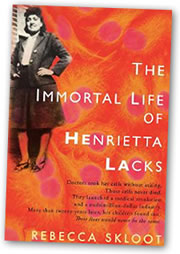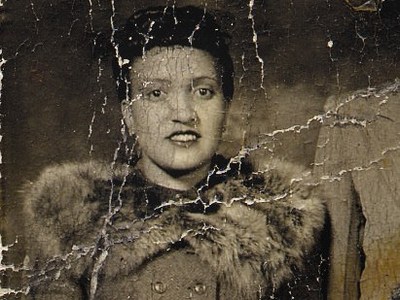by Jane Slaughter
September 29, 2011
Sixty years ago Henrietta Lacks, a poor black woman in Baltimore, unknowingly donated a scraping from her cervical tumor to Johns Hopkins University. She died of aggressive cancer soon after–but her cells lived on. For years scientists had tried to get human cells to multiply in a test tube, and time after time, the cultures had died. For reasons that are still unknown, Lacks’s cancer cells were the first to keep growing, and they are still growing today. “Like guinea pigs and mice,” writes author Rebecca Skloot, “Henrietta’s cells have become the standard laboratory workhorse.”
 Fifty million metric tons of those cells have been cultured, given away, and sold all over the world. Scientists have used them in research that led to drugs for treating herpes, leukemia, flu, hemophilia, and Parkinson’s disease. They’ve been used to study sexually transmitted diseases, longevity, and the genes that cause and suppress cancer, as well as aiding in the creation of polio vaccine, chemotherapy, gene mapping, cloning and in vitro fertilization.
Fifty million metric tons of those cells have been cultured, given away, and sold all over the world. Scientists have used them in research that led to drugs for treating herpes, leukemia, flu, hemophilia, and Parkinson’s disease. They’ve been used to study sexually transmitted diseases, longevity, and the genes that cause and suppress cancer, as well as aiding in the creation of polio vaccine, chemotherapy, gene mapping, cloning and in vitro fertilization.
Lacks’s unwitting donation changed the history of science and of medicine. Last year’s best-seller The Immortal Life of Henrietta Lacks is the story of Lacks herself, of the HeLa cells, as they are known, and of Lacks’s children and what they did after they discovered, 22 years later and by chance, that a piece of their mother was living on.
It’s also the story of how Skloot, a white science journalist, won the trust of Lacks’s daughter Deborah, who was too young when her mother died to remember her and who yearned for Henrietta all her life. Deborah Lacks is not a scientifically minded person. She entertains paranoid thoughts–a sniper will pick her off when she speaks at a public event, she fears, so that scientists can study her body. But the cumulative weight of the story shows where these ideas come from.
Deborah knows about the infamous Tuskegee experiments, for instance, in which the U.S. Public Health Service studied syphilitic black men for 40 years, ending in 1972. The doctors didn’t tell their patients they had syphilis and left them–and their infected wives and children–untreated, letting them die. And enough happened in the Lacks family itself–whose members could seldom afford health insurance–to make its members distrust doctors and scientists, especially white doctors and scientists. And journalists. In 1973, for example, geneticists working with HeLa asked Henrietta’s husband and grown children if they could draw blood. Their goal was to create a map of Henrietta’s genes, but they didn’t explain this well or provide a consent form. Deborah and her brothers thought they were being tested for cancer. When Deborah called the Johns Hopkins switchboard asking for “my cancer results,” she got no information.
The book has aspects of a buddy movie, as Skloot and Deborah Lacks unite in their search for the truth about Henrietta (and, in a scandalous section, about Deborah’s sister Elsie, who died young in an institution formerly known as the Hospital for the Negro Insane).

Henrietta Lacks
One of the most shocking things the reader learns is that people don’t have property rights in their body parts–this in a society where individual property rights are on a pedestal. Despite the seemingly inexorable trend that no human activity should be shielded from the profit motive–public services from schools to garbage collection are contracted out to private companies to make a buck; drug companies patent genes–the human being whose body produced and was produced by those genes or those cells has no right to a share of the profits when a corporation uses them. A patient who’s given blood or a scraping doesn’t even have to be told that scientists are using those tissues.
On second thought, this state of affairs isn’t shocking at all. Profits for drug companies are protected, in judge’s ruling after judge’s ruling; it’s the individual’s rights that are set aside.
Henrietta Lacks was rightly a best-seller. Non-scientists can understand the science; the dispassionate but compassionate portrait of a troubled family rings true.
Skloot says she wanted to write a biography of both the cells and the woman they came from. She keeps the reader compulsively turning pages to find out what happened to both, and to know whether Henrietta ever got her due.
